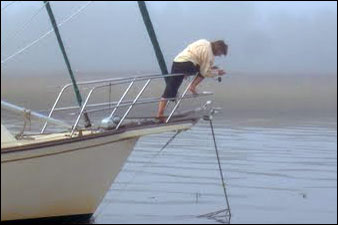
Not every woman comes with a man attached to her hip. For some this is a good situation and for others not so good, but for women wanting to go cruising, it could be seen as a handicap. Certainly the majority of the cruising community is comprised of couples, but it is often surprising to discover that couples you take to be married, not only are not, but may in fact be in arrangements of ease and convenience that have been in place no more than a week, month, or season. By no means does cruising present a closed door for unattached women.
But first and foremost you must be ready to go. You need to face all the major connections in your life and see which ones can be cut and which ones can be put on ice for awhile. Major stumbling blocks to the dream usually are job, family, real estate and relationships. These are entanglements you need to see yourself clear of before putting yourself out there.
The ideal scenario, of course, is to meet a (nice) guy with a (nice) boat. In this day and age people are quick to think of internet matchmaking and personal ads. Perhaps it may work for some, but before she met Dave, Sherry, who was very keen to get back into the cruising lifestyle, tried the internet only to waste a lot of time with guys who weren’t ever going to go. Before she met Tony, Ellen answered an ad in Boat US – “Popeye looking for Olive Oyl,”– behind which was a guy with a Tayana 37 and a plan to sail to Spain. Psyched, Ellen commuted on weekends to sail with him and started trying to figure out how to quit her job…. until an old girlfriend of his resurfaced and Ellen was out. On the other hand, we have known men who’ve placed ads for a cruising companion – essentially a mail-order partner, and we run across them still cruising happily years later. So it can work.
However, it is far more effective to be in situ, that is, physically be in locations where cruisers congregate, get involved in related activities, and let things develop naturally. “Thirty years ago I had a dream of sailing around the world,” says Judy, who was then a lawyer with the IRS, “but my only sailing experience was on small boats on lakes in Michigan. I knew I needed experience on bigger boats on the ocean, so when I couldn’t get the dream out of my head, I took a leave of absence, hopped a plane to the Virgin Islands, and, soon found a job on a charter boat. If you’re a decent cook, it’s fairly easy to find work, and if you’re not, there are boats with larger crews that need stewardesses or deckhands. I really enjoyed working on charter yachts. Sure, I met some pretty weird characters and suffered through a few less-than-ideal jobs, but I also found jobs with great teachers who were happy to show me the ropes.”
Much happier sailing than trapped in an office, Judy eventually became a licensed captain, a well-known charter chef, and executive director of the Virgin Island Charteryacht League. “Once you have some experience and are living the life, all sorts of opportunities open up, including finding like-minded potential significant others!”
Sherry met Dave through SSCA friendships, Ellen met Tony after a race from Annapolis to Solomon’s Island, Judy met Bryan when she signed aboard as chef after he’d brought his boat into charter, and, for that matter, I met Don after we sized each other up on the dock. All four of us met compatible partners by being where sailors congregate, and all of us are since married and out cruising full time.
But do you have to get married to go cruising? I’ll confess this was something I worried about. Would officials in other countries care? Would I stand out as some sort of social pariah? The answer is NO. No one asks, and no one cares. Ellen and Tony sailed together for four years before marrying, Judy and Bryan for three, and Don and I for seven! As in any relationship, when the time is right, the time is right. As Ellen so nicely puts it, “By then, we knew we were committed to each other as much as if we were married.” So, I am appalled when I hear of women, particularly first time cruisers, who insist on being married before setting sail with a boyfriend. What if it doesn’t work out?
What you do need is a binding financial arrangement that covers your you-know-what if things don’t work out, especially if you are out of your home country and most especially if you become a financial partner in the boat (in which case, be sure your name is on the vessel’s document). I recently met Janet who several years ago joined her money and hard work with a guy fitting out a boat to cruise around the world, only to have him tell her, one year into the cruise and in the middle of the Pacific, to get off. And they’d gotten married at his insistence! It’s no easy thing to fight for your rights so far from home.
If you’re not ready to make the kind of jump Judy made thirty years ago, there is an alternative. Crewing.
Most all the major passage-making rallies have provisions for matchmaking extra crewmembers to boats that want them. Alternatively, there are internet-based crew-finding opportunities. Neither of these are paid, professional crew situations, but opportunities to be a watch-standing hand on boats making ocean passages. Arrangements are different in every case, but usually you are expected to pitch in for food expenses and of course you are responsible for you own airfare to and from the rendezvous point.
Recently I met Ruth, a 26-year old woman from Oxford, England who flew into Fiji to crew on a Hallberg Rassey 49 headed on a fast track to Indonesia, the Red Sea and Europe, an ideal-sounding slot she found through www.findacrew.net. Unfortunately, the boat had unanticipated problems coming out of cyclone-season storage, and, after a month of twiddling her thumbs waiting to go, Ruth eventually flew back to New Zealand. However, there she hooked up quickly with another boat passaging north to Fiji with two other hitchhiking crew (including the above-mentioned Janet who refuses to be daunted in making a circumnavigation, even if it has to be piecemeal!) and then in Fiji quickly found another boat sailing on to Australia. Again, the unequivocal advantage of being in place.
Ruth’s experience is a perfect example of the plusses and minuses of crewing for unattached women. For relatively little investment and a lot of flexibility, you get the adventure of long-distance sailing, the chance to learn a great deal about ocean sailing, and the luxury of experiencing a variety of different boats. On the other hand, just as Judy observed, you may have to put up with some weird characters and suffer through a few less than ideal situations, something single women do need to be cautious about.
The biggest negative about being temporary crew is that you are often required to sign off the boat upon arrival and so miss out on the fun, island-hopping part of cruising. You also miss out on the particularly special aspect of traveling the world in your own home. For this reason, some single women take the big step of sailing the world on boats of their own. Stay tuned for Part Two.
Contributing Admirals: Judy Knape, Ursa Minor; Ellen Sanpere, Cayenne III; Sherry McCampbell, Soggy Paws; Ruth Williams and Janet Garnier, crew at large; among others!
This article was published in the October 2008 issue of Latitudes and Attitudes.
Related articles (on this website)
- Single Women Sailing – Part 2 (Admiral’s Angle column #28)
